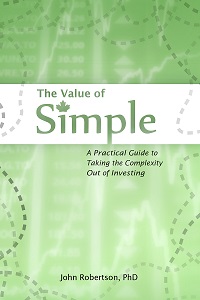Intro to Finance: Mutual Funds
December 10th, 2007 by PotatoBen asked a question about mutual fund fees. That’s somewhat fortunate, as that’s something I just did a bit of research into. It’s somewhat unfortunate since it’s a slightly advanced topic to jump into with “part one”, so I’ll drop my numbering scheme now :)
To briefly cover the background, mutual funds are a collection of stocks, bonds, and cash (sometimes a mixture of all 3, sometimes just stocks) that an investor can buy into. Stocks generally have the best returns over the long term, but can be quite risky. One of the best ways to try to reduce the risk is to diversity into many different stocks, both amongst different individual companies and in companies in different sectors. There are many different rules of thumb about how much diversification one needs, but generally 10-25 different stocks are recommended. I haven’t seen anyone recommend more than 30, since beyond that there isn’t much risk reduction (at that point you should have enough companies and sectors sampled that the only way you’d face significant loss is if the market crashed as a whole), and there becomes a nearly unmanageable amount of data to follow. In addition to the administrative task of following all those stocks, it requires a lot of money to do: each purchase will have a broker fee, and to not have those fees eat up any potential profit, one needs to invest a fair bit in each stock (and that’s not even getting into issues like odd lot trades).
Mutual funds can pool the money from a number of investors and buy a whole crap load of stocks (and bonds, and hold cash). This can free one from the day-to-day stress of watching the market as well as providing a decent amount of diversification.
However, mutual funds often charge a number of fees that can sap their potential returns. There are “front-load” and “back-end” fees, which are basically transaction fees when you buy or sell, respectively. Many back-end fees are for a limited time only, designed to punish early redemption, and to keep people from trading in and out of a mutual fund too much. Of course, “early” can be subjective: some of TD’s mutual funds only have a 90-day lock in period, whereas others can be up to 7 years. Some funds don’t charge these fees (“no-load funds”), but all funds (even no-load ones) will have some sort of recurring expense to cover the cost of administering the fund, paying the managers to select stocks/bonds (if applicable). Advertising, kickbacks to salespeople/advisers, and legal fees are also included in this recurring expense. These recurring fees are called the Management Expense Ratio (MER) and are given as a percent of the fund’s value. The transaction fees/commissions to buy/sell stocks when the fund’s portfolio changes, or when more people buy in (or leave) are another factor, but according to the OSC’s site, aren’t included in the MER.
These MER fees are compounded annually, and you don’t get an invoice or a line-item breakout to see how much they’re costing you each year. They’re simply a negative added on to the fund’s overall growth rate. If the fund’s underlying portfolio of stocks, bonds, and cash went up 7% over the year, but the MER was 1%, you’d see a 6% increase at the end of the year. Likewise, if it was a bad year and the fund just broke even (0% growth in the portfolio), that 1% MER would actually cause you to see a decrease in the fund’s value of 1% at the end of the year.
Canada has some of the highest MERs on mutual funds around, with an average up around 2%. 2% on its own might not sound like much, but when “the market” goes up something like 10% a year in the long term, a 2% hit can be brutal. A mutual fund with a 2% MER, just to keep up with the market would need a gross appreciation of 12% per year (that is, they’d have to beat the market by 2%). It can be done, but usually it’s done only by luck or by the very best investors. I believe the statistic is that only 20% of funds manage to beat the market (or rather, the index they’re compared to) — the rest are either no better, or of course, worse. Also keep in mind that the power of compound interest applies to MER fees as well, though it’s negative in this respect (cutting your compound interest rate from 10% to 8%).
So, there have been some good arguments suggesting that rather than pay 2% to a mutual fund that will likely not end up beating the index it’s measured against, one should instead just buy the index. Some low-cost funds do just that, including the TD e-series funds. These funds are not managed: they simply blindly follow the index (S&P 500, Dow Jones, Scotia Bond Index, etc.) and have a minimal cost (MER of about half a percent — as low as 0.31% for the Canadian Equity index). These low-cost funds can be a great way to get some diversification for a larger portfolio, or form the beginnings of a small one (especially since the TD ones have a low minimum investment of $100).
There are reasons sometimes to pay higher fees. If you genuinely believe a fund will outperform the market (and some do) then that’s a good reason right there. For example, despite the fact that the energy and natural resources sectors are quite hot lately, I think concepts such as peak oil are only going to drive them up further in the future. However, TD doesn’t have a low-cost energy or resources sector fund available: both of those cost 2%. I think for those sectors, I might take the hit since they would be a bit of a gamble to begin with. Also, some RRSPs will only offer a limited selection of mutual funds, all at higher fees. To go out on your own might incur a cost of $100/year for a self-directed RRSP account, which for any portfolio under $5000 would be over the 2% the mutual fund would hit you up for. In those cases, the tax savings of an RRSP might save you.
Getting diversified into foreign stocks is also a great place for mutual funds to shine. Canada is only a small part of the overall world economy, so the argument goes that only a small part of your money should be in Canadian equities. But if you thought it was hard to research and monitor Canadian stocks, doing so on an international scale might well be impossible. So let a mutual fund do it for you. There are some low-fee ones (such as the 0.5% ones at TD) to track European, Japanese, or more broad-based global indexes. Otherwise, this might be a place where it would be acceptable to pay a little bit more.
Don’t however, get suckered into paying a high MER on a mutual fund just because the person at the bank or your financial advisor recommended that fund (or a list of funds). Often, these people will get commissions or kick-backs for selling mutual funds, so they may face a conflict of interest. Likewise, don’t pay it just because a fund is “popular” (you may just be paying for advertising then), or because it’s had good performance in the past. It’s difficult to predict the future, and sometimes past trends carry on… but it could also be that a fund just capitalized on a fad and is about to tank. You’ll need to do a little more research…
A final note is that exchange traded funds (ETFs) typically have very low MERs, it’s sort of their specialty. I’m still researching those after seeing Canadian Captialist talk about them, but I’m a little more in favour of the TD e-series funds. Partly because there’s no transaction fee, whereas I would have to pay a commission for buying/selling an ETF. Partly because the ETFs I looked at (some of the iShares ones on the TSE) were very thinly traded, so the funds were trading a fair bit above what their value would be in terms of holdings. And partly because it’s easier to buy in to the TD ones with very small amounts of money, incrementally. There’s no strict minimum (except for 1 share) for an ETF, but generally when buying shares one wants to go with a “board lot” or 100 shares, which can be a little pricey to start with, and difficult to add to over time. The $100 minimum (which can also buy fractional shares) for the TD funds is much more attractive.
Links:
Investopedia, diversification.
Ontario Securities Commission, mutual fund fees.
InvestorED Mutual Fund fee calculator
Canadian Captialist “Mutual Fund Fee Debate: The Industry Response”
Canadian Captialist “Top Five Reasons to Index Your Portfolio”
Canadian Captialist “Reasons to Avoid Actively Managed Funds”
Canadian Captialist “Two strikes against active management”
Disclaimer: I am not a financial advisor, and this post (or any other) is not to be construed as financial advice. In fact, I’m a graduate student, and thus have obviously made one of life’s worst financial mistakes and you shouldn’t listen to a thing I say. Seek the advice of a professional, and only invest what you can afford to lose in equities.


 Questrade: use QPass 356624159378948
Questrade: use QPass 356624159378948 Passiv is a tool that can connect to your Questrade account and make it easier to track and rebalance your portfolio, including the ability to make one-click trades.
Passiv is a tool that can connect to your Questrade account and make it easier to track and rebalance your portfolio, including the ability to make one-click trades.